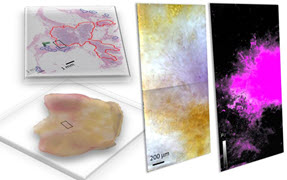Electrically switchable optical vortices
A tornado is a familiar phenomenon. In the optics domain, the analogy is an optical vortex (OV), which has a helical wavefront. OV beams are also called doughnut beams due to their dark centers. The unique properties of these devices have attracted much attention and led to their wide use in many fields.1–5 They can be created in a number of ways, including computer-generated holograms (CGHs), mode converters, phase masks, and spiral phase plates. For some applications, OVs that can be electrically switched at fast speed are highly desirable. One example is optical tweezers that can move a particle to a desired position and then release it, like an excavator grab.
Here, we present a straightforward way of producing OVs by recording a CGH mask in a composite material of polymers and liquid crystals (polymer-dispersed liquid crystal, PDLC).6 In our configuration, the refractive index (i.e., the ratio of the speed of light in a vacuum to the speed of light through the material) of the polymer is set to be equal to the ordinary refractive index of the liquid crystal (LC), no. Following phase separation, at which point the constituents of the composite are no longer homogeneously mixed, polymer- and LC-rich regions will form in the PDLC. When no voltage is applied, the LC molecules are randomly distributed in the LC-rich regions, and their effective refractive index is larger than that of the polymer. When light passes through the PDLC film, the resulting index difference between the two regions induces a relative phase difference, Δδ. This can be written as

where d is the cell gap (i.e., the distance between two pieces of conducting glass filled with PDLC), λ is the wavelength, and neff and np are the LC effective and polymer refractive indices, respectively.
The OV beam cannot be obtained directly by the photomask, but rather is produced by using a Fourier lens to make a transform of the light. This ‘reconstruction’ process can be carried out via a conventional CGH setup. Under the influence of voltage, the LC director (the preferred orientation of the LCs) realigns along the direction of the electric field. If the LC and polymer refractive indices match, the composite film becomes a homogeneous medium and the phase difference disappears. This, in turn, switches off the OV.
In our experiments, we first calculated a CGH pattern based on the interferogram of two waves: a planar reference wave and an object wave containing the desired OV.7 We then used a laser printer to transfer the pattern to a transparency for use as a photomask, as shown in Figure 1(a). When the photomask was clipped onto a cell and exposed to a collimated laser beam, the photopolymerization-induced phase separation caused the pattern to be recorded in the PDLC. The morphology in the PDLC after separation is shown in Figure 1(b). The brighter area is the polymer-rich region, and the darker the LC-rich.

Figure 2 shows photographs of the reconstructed OV at V = 0 (a) and V = 70Vrms (b). It is clear that when enough voltage is applied, the reconstructed OVs become blurred and even disappear for the higher-order diffraction owing to the refractive index change in the LC region. In other words, the OV can be switched off electrically. The OV also shows a response time typical of most PDLC devices, which is on the order of a microsecond.
At present, the efficiency of these OVs is still low (only about 13–17%) for far-reaching applications such as optical trapping and communications. Our next steps aim at boosting performance to more than 60% by converting the binary amplitude CGH mask into a Bragg volume phase-type (i.e., highly efficient) hologram in PDLC.
This project is supported by an Info-Communications Technology grant (Idea Bank) under grant 2006ICTG03 of Nanyang Technological University, Singapore.
Y. J. Liu was born in Shandong, China. He received his BEng in optoelectronics from Shandong University, China, in 2000, an MS in optics from Fudan University, China, in 2003, and a PhD in photonics from Nanyang Technological University, Singapore, in 2007. His research focuses on liquid crystal photonics.
X. W. Sun is an associate professor of the Division of Microelectronics in the School of Electrical and Electronic Engineering of Nanyang Technological University. His research is concerned with nanotechnology, display technologies, and liquid crystal devices. He is a senior member of the IEEE and a member of the Society for Information Display (SID). He is the founding chair of the SID Singapore and Malaysia chapter.




